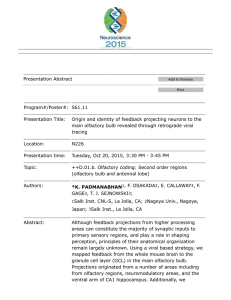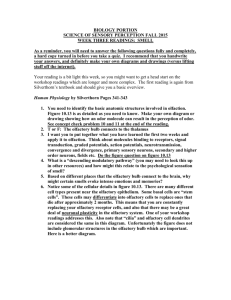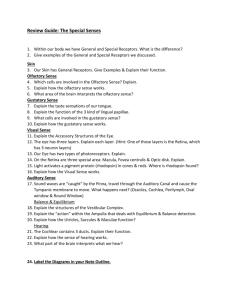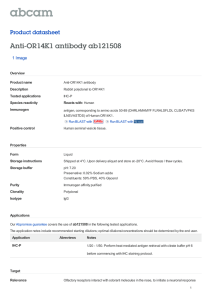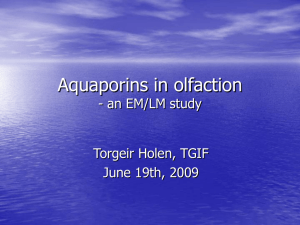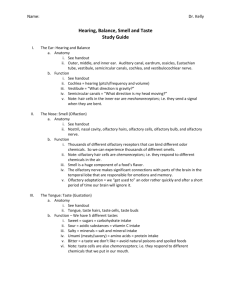Document 13308206
advertisement
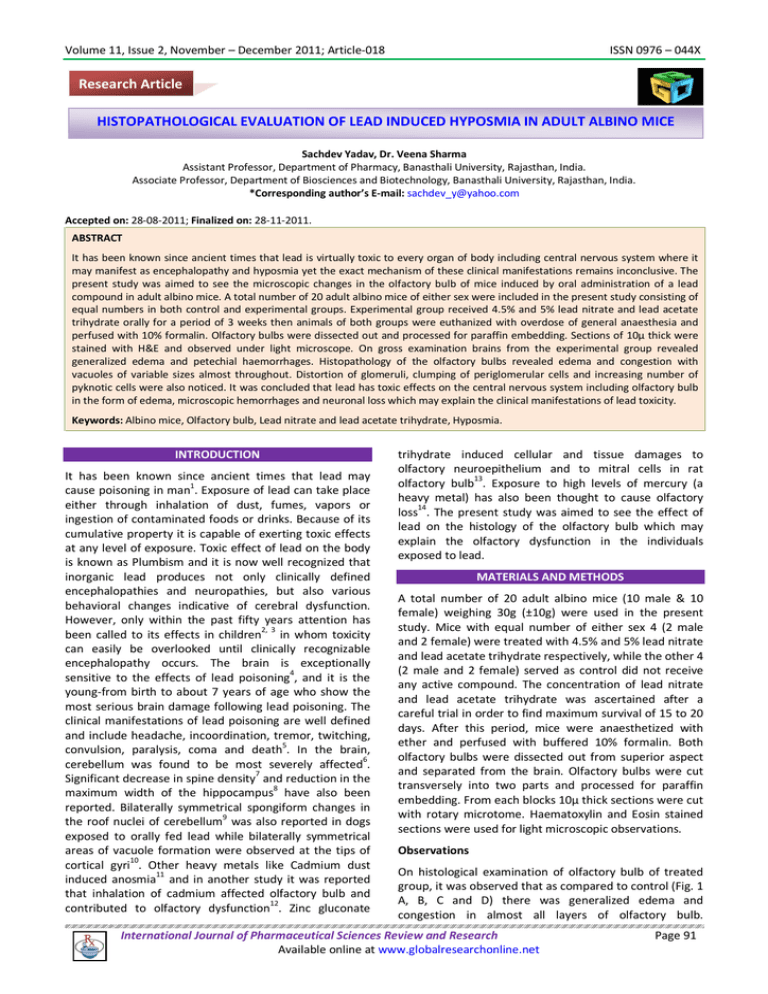
Volume 11, Issue 2, November – December 2011; Article-018 ISSN 0976 – 044X Research Article HISTOPATHOLOGICAL EVALUATION OF LEAD INDUCED HYPOSMIA IN ADULT ALBINO MICE Sachdev Yadav, Dr. Veena Sharma Assistant Professor, Department of Pharmacy, Banasthali University, Rajasthan, India. Associate Professor, Department of Biosciences and Biotechnology, Banasthali University, Rajasthan, India. *Corresponding author’s E-mail: sachdev_y@yahoo.com Accepted on: 28-08-2011; Finalized on: 28-11-2011. ABSTRACT It has been known since ancient times that lead is virtually toxic to every organ of body including central nervous system where it may manifest as encephalopathy and hyposmia yet the exact mechanism of these clinical manifestations remains inconclusive. The present study was aimed to see the microscopic changes in the olfactory bulb of mice induced by oral administration of a lead compound in adult albino mice. A total number of 20 adult albino mice of either sex were included in the present study consisting of equal numbers in both control and experimental groups. Experimental group received 4.5% and 5% lead nitrate and lead acetate trihydrate orally for a period of 3 weeks then animals of both groups were euthanized with overdose of general anaesthesia and perfused with 10% formalin. Olfactory bulbs were dissected out and processed for paraffin embedding. Sections of 10µ thick were stained with H&E and observed under light microscope. On gross examination brains from the experimental group revealed generalized edema and petechial haemorrhages. Histopathology of the olfactory bulbs revealed edema and congestion with vacuoles of variable sizes almost throughout. Distortion of glomeruli, clumping of periglomerular cells and increasing number of pyknotic cells were also noticed. It was concluded that lead has toxic effects on the central nervous system including olfactory bulb in the form of edema, microscopic hemorrhages and neuronal loss which may explain the clinical manifestations of lead toxicity. Keywords: Albino mice, Olfactory bulb, Lead nitrate and lead acetate trihydrate, Hyposmia. INTRODUCTION It has been known since ancient times that lead may cause poisoning in man1. Exposure of lead can take place either through inhalation of dust, fumes, vapors or ingestion of contaminated foods or drinks. Because of its cumulative property it is capable of exerting toxic effects at any level of exposure. Toxic effect of lead on the body is known as Plumbism and it is now well recognized that inorganic lead produces not only clinically defined encephalopathies and neuropathies, but also various behavioral changes indicative of cerebral dysfunction. However, only within the past fifty years attention has been called to its effects in children2, 3 in whom toxicity can easily be overlooked until clinically recognizable encephalopathy occurs. The brain is exceptionally sensitive to the effects of lead poisoning4, and it is the young-from birth to about 7 years of age who show the most serious brain damage following lead poisoning. The clinical manifestations of lead poisoning are well defined and include headache, incoordination, tremor, twitching, 5 convulsion, paralysis, coma and death . In the brain, 6 cerebellum was found to be most severely affected . 7 Significant decrease in spine density and reduction in the 8 maximum width of the hippocampus have also been reported. Bilaterally symmetrical spongiform changes in the roof nuclei of cerebellum9 was also reported in dogs exposed to orally fed lead while bilaterally symmetrical areas of vacuole formation were observed at the tips of cortical gyri10. Other heavy metals like Cadmium dust induced anosmia11 and in another study it was reported that inhalation of cadmium affected olfactory bulb and contributed to olfactory dysfunction12. Zinc gluconate trihydrate induced cellular and tissue damages to olfactory neuroepithelium and to mitral cells in rat olfactory bulb13. Exposure to high levels of mercury (a heavy metal) has also been thought to cause olfactory loss14. The present study was aimed to see the effect of lead on the histology of the olfactory bulb which may explain the olfactory dysfunction in the individuals exposed to lead. MATERIALS AND METHODS A total number of 20 adult albino mice (10 male & 10 female) weighing 30g (±10g) were used in the present study. Mice with equal number of either sex 4 (2 male and 2 female) were treated with 4.5% and 5% lead nitrate and lead acetate trihydrate respectively, while the other 4 (2 male and 2 female) served as control did not receive any active compound. The concentration of lead nitrate and lead acetate trihydrate was ascertained after a careful trial in order to find maximum survival of 15 to 20 days. After this period, mice were anaesthetized with ether and perfused with buffered 10% formalin. Both olfactory bulbs were dissected out from superior aspect and separated from the brain. Olfactory bulbs were cut transversely into two parts and processed for paraffin embedding. From each blocks 10µ thick sections were cut with rotary microtome. Haematoxylin and Eosin stained sections were used for light microscopic observations. Observations On histological examination of olfactory bulb of treated group, it was observed that as compared to control (Fig. 1 A, B, C and D) there was generalized edema and congestion in almost all layers of olfactory bulb. International Journal of Pharmaceutical Sciences Review and Research Available online at www.globalresearchonline.net Page 91 Volume 11, Issue 2, November – December 2011; Article-018 Capillaries appeared dilated and congested. Distortion of glomerular contour was obvious. Periglomerular cells were hyperchromatic and showed clumping. Multiple vacuoles of variable sizes were noticed in the outer plexiform layer (Fig. 1 E, F, G and H). Granule cell layer showed loss of cells. Dark and pyknotic nuclei were also present. No such types of abnormalities were found in control group of mice. ISSN 0976 – 044X incubation of guinea pig hippocampus in a lead containing medium20 which was more pronounced in outer plexiform layer of olfactory bulb. The vascular changes observed in the present study are in agreement with those reported 5 after exposure of lead in dogs which indicates that irrespective of animal species, olfactory bulb is vulnerable to lead acetate toxicity. CONCLUSION From the above study it was concluded that olfactory bulb is vulnerable to toxicity of lead similar to the other parts of brain and that histopathological changes mainly included edema, vacuolation and congestion, glomerular distortion and pyknotic periglomerular cells. Acknowledgements We acknowledge the co-operation of technical and other supporting staff, Banasthali University, Rajasthan. REFERENCES Figure 1: Photomicrographs from olfactory bulb of control mice (A, B, C and D) showing typical laminar pattern without edema, congestion or vacuolation while those from experimental group (E, F, G and H) show edema, vacuolation, congestion, loss of glomerular contour and clumping of periglomerular cells. H &E stain, X100 (A &C). X400 (B&D). DISCUSSION The layers of the olfactory bulb which show damage mainly include the lamina glomerulosa, outer plexiform layer and the granule cell layer. Gross damage in the region of olfactory bulb was also seen in present study in the form of petechial haemorrhage which might have been due to capillary dilatation. These findings are in partial agreement with those reported by certain workers15 who exposed adult guinea pig to Lead carbonate and reported vascular changes in addition to encephalopathic effects of lead mediated directly at the neuronal level. Some other workers16 have demonstrated hypertrophy of vascular pericytes. Lead pellets implantation in the mice forebrain produced vascular changes in addition to parenchymal necrosis and spongiosis in the hypothalamus17. Histological study of many parts of brain e.g. cerebral cortex, corpus striatum, choroid plexus and cerebellum after lead exposure revealed cerebellum to be most severely damaged6. In addition in this study6 hemorrhages noticed along with damage to molecular and Purkinje cell layers and edema in the granule cell layer which correlated very well with the findings of the present study. Histopathological findings of olfactory bulb on neuron and neuropil in the present study are to a great extent in agreement with those reporting degeneration of cells in 8 the cerebral cortex and reduced number of Purkinje and 18 granule cells of cerebellum and of hippocampal neurons on lead exposure19 as well as vacuolations after 1. Major, R. H. Classic description of diseases. Charles C Thomas, Springfield, Ill., 1932, 110-176. 2. Holt, L. E. Lead poisoning in infancy. Am. J. Dis. Child. 25, 1923, 299. 3. McKhann, C. F. and Vogt, E. C. Lead poisoning in children. JAMA 101, 1933, 1131. 4. Goyer, R. A., and Rhyne, B. C., Pathological effects of lead. Int. Rev. Pathol. 2, 1973, 2. 5. Balbus-Kornfeld JM, Stewart W, Bolla KI. Schwartz BS; Cumulative exposure to inorganiclead and neurobehavioral test performance in adults: an epidemiological review Journal: Occup Environ Med 52, 1995, 2-12. 6. Press, MF; Lead encephalopathy in neonatal Long-Evans rats: morphologic studies. J Neuropathol Exp Neurol. 36, 1977, 169-93. 7. Patrick GW, Anderson WJ; Dendritic alterations of cerebellar Purkinje neurons in postnatally lead-exposed kittens. Dev Neurosci. 22, 2000, 320-8. 8. Bansal MR, Kausiial N. Banerjee UC; Effect of oral lead acetate administration on the mouse brain, J Trace Elem Exp Med, 3, 1990, 235-246. 9. Hamir AN, Sullivan ND, Handson PD; Neuropathological lesions in experimental lead toxicosis of dogs. Neurobiol Aging, 5, 1984, 297-307. 10. Stowe HD, Vandevelde M; Lead-induced encephalopathy in dogs. J Neuropathol Exp Neurol; 38, 1979, 463-74. 11. Adam and Crabtree. Anosmia in alkaline battery workers. Br J Ind Med. 18, 1961, 216-221. 12. Jean Robert; Harmful effects of cadmium on olfactory system in Mice. Inhalation toxicology. 20, 2008, 11691177. 13. Carboni AA; Oral administration of zinc gluconate trihydrate. Am J Rhinology. 20,2006, 262-268. International Journal of Pharmaceutical Sciences Review and Research Available online at www.globalresearchonline.net Page 92 Volume 11, Issue 2, November – December 2011; Article-018 ISSN 0976 – 044X 14. Upadhya U; Olfactory loss as a result of toxic exposure.Otolaryngo Clinics of North America; 37, 2004, 1185-1207. 18. McConnell P, Berry M; The effects of postnatal lead exposure on Purkinje cell dendritic development in the rat. Am. J. Dis. Child; 133, 1979, 786-90. 15. Bouldin and krigman; Acute lead encephalopathy in the guinea pig. Acta Neuropathologica; 33, 1975, 185-190. 19. Zook BC, London WT, Wilpizeski CR, Sever JL: Experimental lead paint poisoning in nonhuman primates. Pathologic findings; Brain Res; 189, 1980, 369-76. 16. Markov DV and Dimova RN; Ultrastructurai alterations of rat brain microglial cells and pericytes after chronic lead poisoning. Acta Neuropathol; 1974, 25-35. 17. Hirano A and Kochen JA; Some effects of intracerebral lead implantation in the rat; Acta Neuropathol (Berl) 30, 1975, 307-15. 20. Brink U, Wechsler W; Microscopic examination of hippocampal slices alters short-term lead exposure in vitro. Neurotoxicol Teratol; 11, 1985, 539-43. ***************** International Journal of Pharmaceutical Sciences Review and Research Available online at www.globalresearchonline.net Page 93
